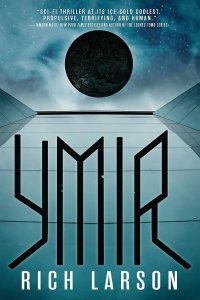Paul Di Filippo Reviews Ymir by Rich Larson
 Ymir, Rich Larson (Orbit 978-0316416580, trade paperback, 416pp, $17.99) July 2022.
Ymir, Rich Larson (Orbit 978-0316416580, trade paperback, 416pp, $17.99) July 2022.
If one tried to engineer a young writer who would embody all the core values, tactics, and ambiance of Classic SF while still conveying ultra-contemporary attitudes, ambiance, and affect, one could hardly produce a better candidate than Rich Larson. Just turned thirty years old, he’s already delivered over a hundred fine stories and now brings us his third novel, Ymir, a standalone. When reading him, you can easily view him as the newest glowing star on a timeline that includes simpatico scribes such as Gordon Dickson (b. 1923), Keith Laumer (b. 1925), Robert Reed (b. 1956), Richard Morgan (b. 1965), Lavie Tidhar (b. 1976) and Sam Miller (b. 1979). With a distinctive voice and worldview, he nonetheless carries forward the rich tradition of his stefnal ancestors.
In my review of Larson’s first book, Annex, I made a couple of observations which hold true for Ymir as well:
“Larson crams a superabundance of action into just a few days of realtime for his characters. The pacing is nonstop, and just when you think a certain pattern has assumed permanence, he fruitfully upsets it…. [and he] has a cinematic eye for depicting the disturbing shadows and tumbled vistas of the wreckage of his world…”
Our hero this time around is a fellow named Yorick Metu. Raised poor and oppressed on the harsh planet Ymir, he has since escaped what seemed to be his inevitable fate, but not by an enviable route. As he grew older on Ymir he fell into the employment of the corporate overlords who eventually came to run the planet as a mining colony. As a character named Fen realizes: “She knows that Yorick is the worst sort of company man, the kind who betrayed his own blood during Subjugation.” Fleeing his homeworld, he became a hunter-killer, his special prey being the strange quasi-machine beings known as “grendels.” Yorick never intended to return to Ymir, but his boss and handler, a woman named Gausta, has him forcibly decanted there, out of his interstellar hibernation status, to deal with a grendel incursion. So now Yorick has to face not only a deadly xenotech predator, but all the ghosts of his past.
Small early-plot spoiler: One such ghost, who will become a tangible reality, is his younger brother Thello, once loved and protected, now an enemy. This dynamic of fraught sibling love-hate is a large powerful engine for the book.
The planet Ymir—as we might assume from its status as the book’s title-bearer—will hold a large place in the action, and Larson evokes it magnificently. It’s basically a frozen hellworld, where life is confined to the Cut, a deep long crevasse roofed over with a projection-screen ceiling.
All of it seething under an artificial sky, a holo meant to help people forget they’re living in a shallow wound in Ymir’s crust. Instead of a sunrise he sees an aching white blank. Jagged black cracks flicker across it. Stray lines of code scroll through and disappear.
Still glitching. He was gone for ten years his time, twenty here, and the sky is still fucking glitching.
This imagery—which has to instantly conjure up Gibson’s famous line—“The sky above the port was the color of television, tuned to a dead channel.”—also discloses Larson’s love for and debt to cyberpunk. Yorick’s wounded antihero stature, his druggy nihilism and cynicism that conceal a bleeding heart, along with the various cyborgs, hackers, bartender brains in vats and other riffraff that populate the Cut, all constitute a fresh yet quintessential cyberpunk presentation. I grew very fond of the character Nocti, who could have stepped out of Delany’s Nova:
The musician gives him a long look. Then he reaches down and unzips the black body glove from his left leg, exposing a long bony limb that bulges in strange places. He rests his bare foot on the stool across from him. As Yorick watches, the pasty esh of the man’s thigh slides apart and his leg unfolds, insectoid, into a metal-stringed instrument.
He tunes, then sets his saw to the strings and starts to play.
To say that all of the action is confined to a small patch on a lone planet, Larson manages to convey a sense of the largeness of his galactic milieu, especially through scenes involving the ancient grendels and a mysterious structure of the long-departed forerunner “Oldies” that is dubbed “the ansible.” He could easily bring us more adventures in this scenario, but maybe not necessarily featuring Yorick, who, by novel’s end, has traversed a full and life-changing arc.
Fans of M. John Harrison’s sophisticated space operas will encounter in Larson’s newest a worthy shelf-mate. And I am certain that someone even younger than Larson will soon read Ymir and find it a formative and influential milestone in his or her writerly development, forging yet another link in the golden chain of science fiction!
 While you are here, please take a moment to support Locus with a one-time or recurring donation. We rely on reader donations to keep the magazine and site going, and would like to keep the site paywall free, but WE NEED YOUR FINANCIAL SUPPORT to continue quality coverage of the science fiction and fantasy field.
While you are here, please take a moment to support Locus with a one-time or recurring donation. We rely on reader donations to keep the magazine and site going, and would like to keep the site paywall free, but WE NEED YOUR FINANCIAL SUPPORT to continue quality coverage of the science fiction and fantasy field.
©Locus Magazine. Copyrighted material may not be republished without permission of LSFF.





